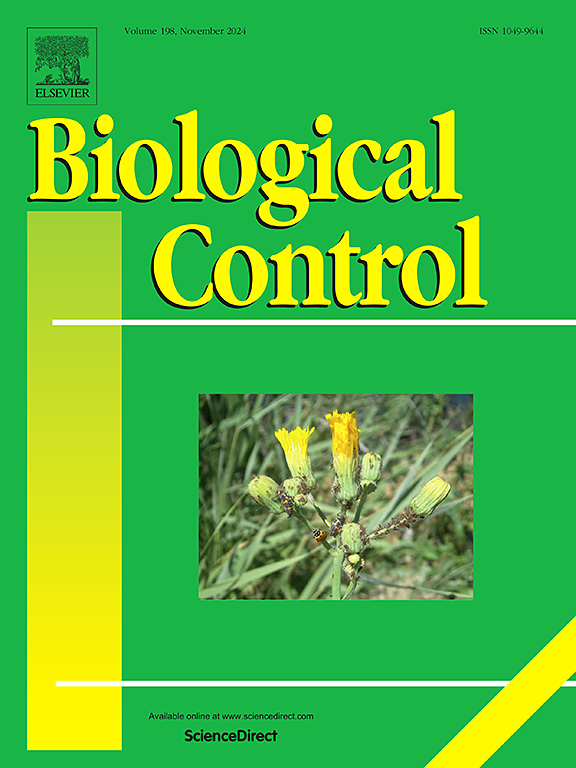Harnessing Chelonus inanitus for efficient Spodoptera spp. management: Learning about production to explore roles in Baculovirus transmission
IF 3.7
2区 农林科学
Q2 BIOTECHNOLOGY & APPLIED MICROBIOLOGY
引用次数: 0
Abstract
Control of Spodoptera spp. (Lepidoptera: Noctuidae) crop pests has traditionally relied on heavy insecticide use. Baculoviruses (BV) from the genera Alphabaculovirus and Betabaculovirus offer effective, species-specific alternatives for managing their outbreaks. Joint use of BVs with natural enemies, such as parasitoids, could further enhance control of Spodoptera spp. by contributing to virus dispersion. In a series of experiments, we studied the optimal host age and parasitization duration of the endoparasitoid Chelonus inanitus L. (Hymenoptera: Braconidae) for parasitoid production, as well as the parasitoid preference and mechanical transmission of Spodoptera exigua and Spodoptera littoralis multiple nucleopolyhedroviruses (SeMNPV and SpliMNPV). We found that parasitoid progeny production was significantly lower when parasitized eggs were either too young (24 h) or too old (96 h), highlighting the importance of host egg age. Additionally, there was an increasing trend in parasitoid offspring production with longer parasitization exposure times, particularly at 6 and 24 h compared to shorter durations. Chelonus inanitus did not discriminate between SpliMNPV-contaminated and non-contaminated eggs, but had a remarkable preference for SeMNPV-contaminated eggs. The parasitoid effectively dispersed BVs, not only from BV-treated eggs to heathy ones by parasitization, but also, and even more efficiently, by the sole contact with a contaminated surface without eggs. Understanding complex BV-parasitoid interactions is crucial for developing integrated pest management strategies that maximize the efficacy of both parasites.
利用线虫进行有效的夜蛾管理:学习生产以探索杆状病毒传播中的作用
控制夜蛾科(鳞翅目:夜蛾科)作物害虫传统上依赖于大量使用杀虫剂。来自甲杆状病毒属和倍杆状病毒属的杆状病毒(BV)为管理其暴发提供了有效的、物种特异性的替代方案。bv与寄生蜂等天敌联合使用,可通过促进病毒传播,进一步加强对夜蛾的控制。在一系列实验中,我们研究了拟内寄生蜂切茧蜂(Chelonus inanitus L.,膜翅目:小蜂科)的最佳寄主年龄和寄生时间,以及小夜蛾和沿海夜蛾多核多角体病毒(SeMNPV和SpliMNPV)的寄生性偏好和机械传播。研究发现,寄主卵龄过小(24 h)或过老(96 h)均显著降低了寄生蜂的子代产量,说明寄主卵龄的重要性。此外,与较短的寄生时间相比,随着寄生时间的延长,特别是在6和24 h时,寄生蜂的后代产量呈增加趋势。螯虾对splimnpv污染的卵和未污染的卵没有区别,但对semnpv污染的卵有显著的偏好。寄生蜂不仅可以通过寄生的方式将bv从被bv处理过的卵传播到健康的卵上,而且还可以通过单独接触没有卵的被污染的表面来更有效地传播bv。了解bv -拟寄生虫之间复杂的相互作用对于制定综合虫害管理策略,最大限度地提高两种寄生虫的功效至关重要。
本文章由计算机程序翻译,如有差异,请以英文原文为准。
求助全文
约1分钟内获得全文
求助全文
来源期刊

Biological Control
生物-昆虫学
CiteScore
7.40
自引率
7.10%
发文量
220
审稿时长
63 days
期刊介绍:
Biological control is an environmentally sound and effective means of reducing or mitigating pests and pest effects through the use of natural enemies. The aim of Biological Control is to promote this science and technology through publication of original research articles and reviews of research and theory. The journal devotes a section to reports on biotechnologies dealing with the elucidation and use of genes or gene products for the enhancement of biological control agents.
The journal encompasses biological control of viral, microbial, nematode, insect, mite, weed, and vertebrate pests in agriculture, aquatic, forest, natural resource, stored product, and urban environments. Biological control of arthropod pests of human and domestic animals is also included. Ecological, molecular, and biotechnological approaches to the understanding of biological control are welcome.
 求助内容:
求助内容: 应助结果提醒方式:
应助结果提醒方式:


